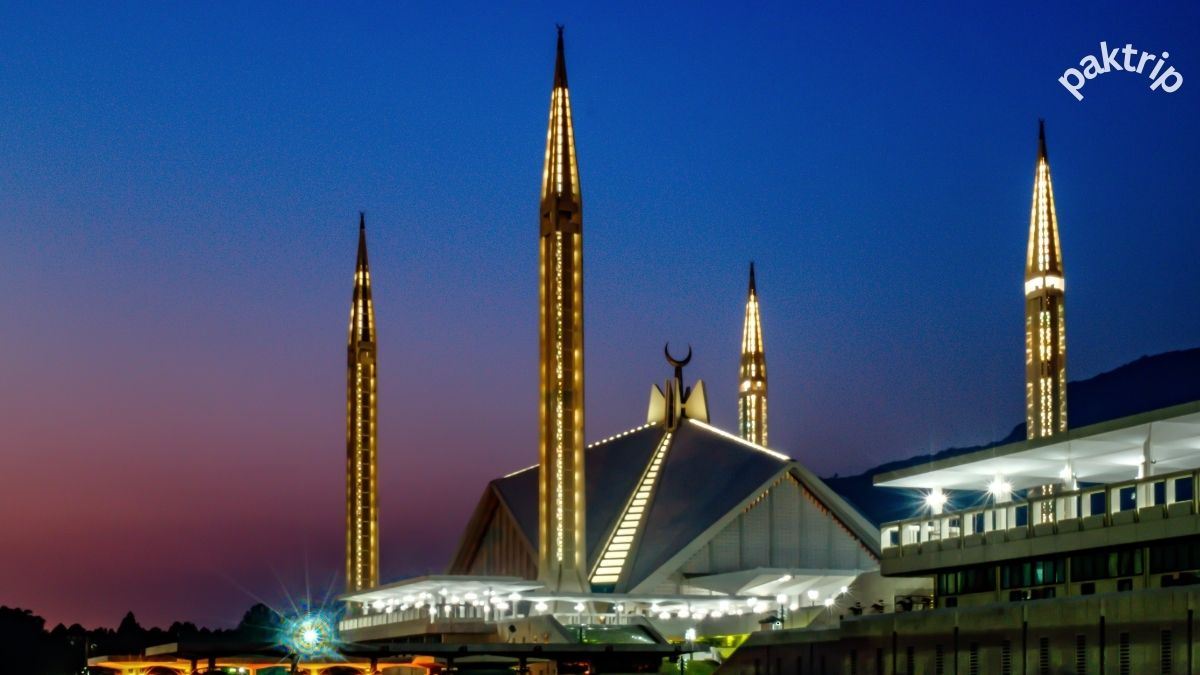Faisal Masjid Islamabad: Pakistan’s Iconic Symbol of Faith
Faisal Masjid Islamabad is more than just a place of worship; it is an iconic symbol of Pakistan’s Islamic identity, history, and deep ties with the Muslim world. Located in the picturesque setting at the foot of the Margalla Hills, it is an architectural masterpiece and one of the largest mosques in the world. Its unique design, size, and cultural significance have made it one of the most visited landmarks in Pakistan. This article will explore the rich history, stunning architecture, and symbolic importance of Faisal Masjid.
The Origins of Faisal Masjid Islamabad
The story of Faisal Masjid begins in 1966 when King Faisal bin Abdul Aziz of Saudi Arabia visited Pakistan. During this visit, he envisioned a grand mosque that would symbolize unity among Muslims and strengthen the bond between Pakistan and Saudi Arabia. The project aimed to create a national mosque in Islamabad that would not only be a place of worship but also a representation of Pakistan’s Islamic heritage.
In 1969, an international architectural competition was organized to select a design for the mosque. This competition attracted 17 talented architects from around the world. Turkish architect Vedat Dalokay won the competition with his bold and innovative design. He planned to construct a mosque that would break away from traditional Islamic architecture and reflect modernity while maintaining the spiritual essence of Islam.
Dalokay’s design was unlike any other mosque in the world. Instead of the conventional domed structure, the Faisal Masjid was designed to resemble a Bedouin tent, symbolizing the simplicity of nomadic life and Islamic traditions. Construction began in 1976 and took ten years to complete, with the mosque being officially inaugurated in 1986.
Why Is It Called Faisal Masjid?
The mosque was named Faisal Masjid in honor of King Faisal bin Abdul Aziz, who played a crucial role in initiating the project. King Faisal’s financial support and vision were instrumental in the creation of this grand mosque. Unfortunately, King Faisal was assassinated in 1975, before he could witness the completion of the mosque. To honor his legacy, the mosque was named after him, and the main road leading to it is called Faisal Avenue.
The name of Faisal Masjid is not just a tribute to King Faisal but also a symbol of the enduring relationship between Saudi Arabia and Pakistan. This bond, built on mutual respect and shared Islamic values, continues to be cherished by both nations.
The Architectural Wonder of Faisal Masjid
One of the key features that make Faisal Masjid unique is its architecture. Unlike traditional mosques, which typically feature large domes and minarets, Faisal Masjid has a modern, tent-like structure. This design was chosen to reflect the purity and simplicity of Islam, while also standing as a modern architectural marvel.
The mosque’s main prayer hall is shaped like a desert tent, with four towering minarets at each corner. These minarets rise to a height of 88 meters, making them some of the tallest minarets in the world. The absence of traditional domes makes the Faisal Masjid stand out as a one-of-a-kind structure that marries modern design with Islamic principles.
The mosque covers an area of approximately 5,000 square meters and can accommodate around 100,000 worshippers at a time, including 10,000 inside the main prayer hall. When it was completed in 1986, Faisal Masjid was the largest mosque in the world, a title it held until 1993. Today, it remains one of the top five largest mosques globally, known not only for its size but also for its beauty and unique design.
The Symbolism of Faisal Masjid
Faisal Masjid holds deep symbolic meaning for Pakistan. It is the National Mosque of Pakistan and serves as a symbol of the country’s Islamic identity. It is also a reminder of the close historical ties between Pakistan and Saudi Arabia. The mosque was granted the title of Nishan-e-Pakistan, which is the highest civilian award given to both Pakistani citizens and foreign nationals.
The mosque’s design reflects both the simplicity and grandeur of Islamic culture. The tent-like structure of the mosque is meant to represent the nomadic traditions of the Arabian Peninsula, where Islam was born. This connection between the past and present is what gives Faisal Masjid Islamabad its unique and timeless appeal.
Construction of Faisal Masjid: A Collaborative Effort
The construction of Faisal Masjid was a massive project that involved collaboration between Pakistan and Saudi Arabia. Pakistan’s National Construction Limited was responsible for the building process, while Saudi Arabia provided significant financial support. The total cost of the mosque’s construction was approximately 130 million Saudi Riyals, which was roughly equivalent to $120 million at the time.
The mosque’s construction was a complex task due to its innovative design and massive scale. It took nearly a decade to complete the project, with construction beginning in 1976 and concluding in 1986. The mosque’s striking design and grandeur made it a subject of global admiration, and it continues to be regarded as one of the most impressive architectural achievements in the Islamic world.
A Spiritual and Cultural Destination
Visiting Faisal Masjid is a memorable experience for both tourists and worshippers. The mosque is not only a place of religious significance but also a cultural and architectural landmark. Its location at the foot of the Margalla Hills provides a serene and peaceful atmosphere, making it a popular spot for visitors looking for spiritual reflection and tranquility.
The mosque is especially captivating during the Maghrib prayer at sunset. As the sun sets behind the Margalla Hills, the mosque is illuminated, creating a breathtaking sight. The call to prayer echoes from the tall minarets, adding to the spiritual ambiance of the mosque.
Inside, the prayer hall is vast and open, with simple yet elegant Islamic geometric patterns adorning the walls and ceilings. Visitors are welcome to explore the mosque’s grounds and learn about its history. Guided tours are available, offering deeper insights into the mosque’s design, construction, and significance.
The Legacy of Faisal Masjid
Faisal Masjid has become more than just a place of worship; it is a symbol of Pakistan’s progress and its deep connection to the Muslim world. Over the years, the mosque has hosted numerous international Islamic conferences and gatherings, further cementing its status as a global icon of Islamic unity.
The mosque’s legacy continues to grow as it attracts visitors from all over the world. From foreign dignitaries to scholars and tourists, people come to Faisal Masjid to admire its unique design, learn about its history, and experience its spiritual significance.
The presence of Faisal Masjid in Islamabad also adds to the capital city’s beauty and charm. It is one of the top tourist destinations in Pakistan, offering a glimpse into the country’s rich Islamic heritage and its modern architectural achievements.
Conclusion
Faisal Masjid Islamabad stands as a testament to Pakistan’s Islamic heritage, its close ties with Saudi Arabia, and its commitment to preserving Islamic culture. With its unique architectural design, historical significance, and symbolic meaning, the mosque continues to be a source of pride for Pakistan and the Muslim world.
Whether you are visiting Islamabad for religious purposes or to appreciate the beauty of its landmarks, Faisal Masjid should be at the top of your list. Its serene location, majestic architecture, and spiritual ambiance make it an unforgettable experience for anyone who visits.
Plan your visit to Faisal Masjid and witness the magnificence of one of the world’s most remarkable mosques.







